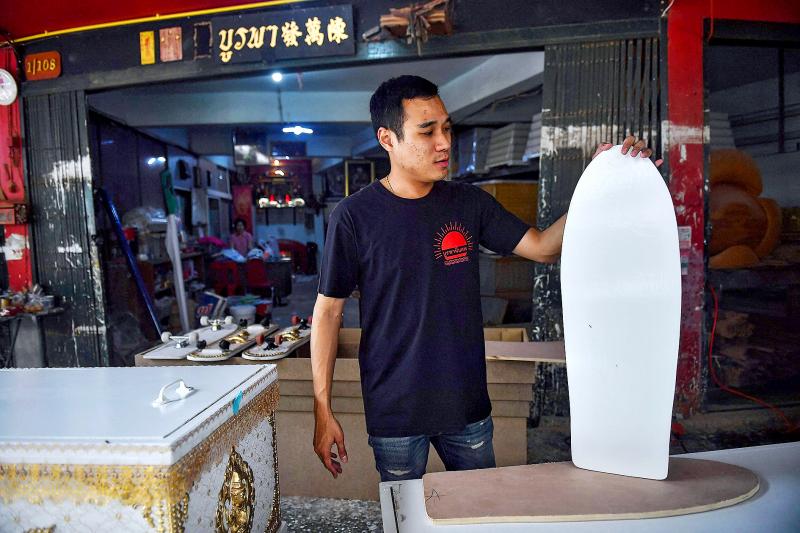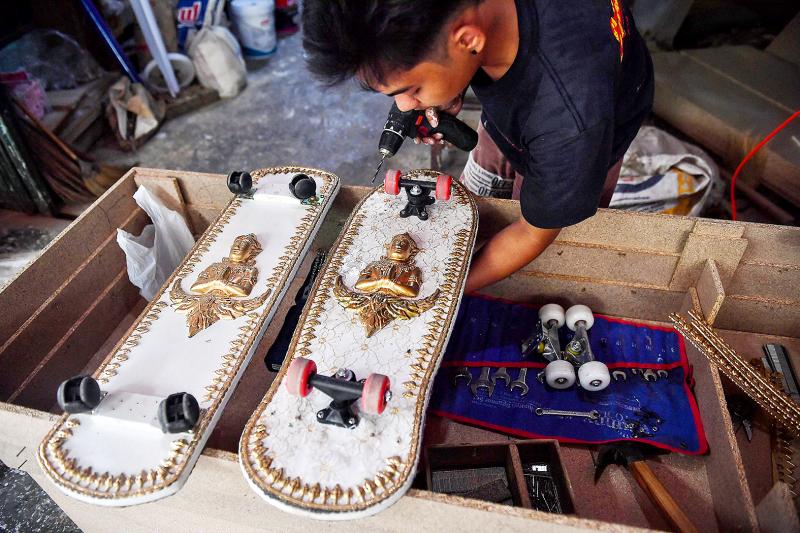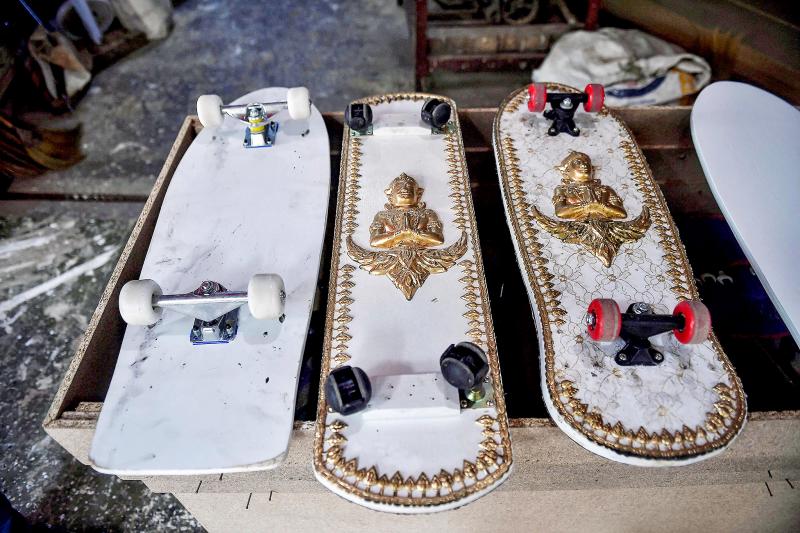From a final resting place for the dead to a gnarly way to land a trick; a Thai coffin-maker is affixing Buddhist emblems to the dismantled walls of his caskets, and transforming them into skateboards.
As the popularity of board sports exploded in Thailand, and the price of a skateboard skyrocketed, Anusorn Yungyearn decided to breathe new life into some of the wooden caskets he had lying around his Bangkok workshop.
“I want to give the kids who don’t really have much chance in life an opportunity to skate,” said the 30-year-old.

Photo: AFP
“I also don’t want them to ask their parents to buy one for them since the cost of it is really high.”
In the past year hordes of young Thais have taken up skateboarding and surf-skating — likely a consequence of most social spaces like bars and gyms being closed for months at a time because of pandemic restrictions.
Today, bands of young skaters can be seen cruising through Bangkok’s historic quarter and its universities’ open spaces.

Photo: AFP
Anusorn’s warehouse has coffins with brocade designs, golden lattice work and even holographic stick-ons. But for his boards, he has decided to keep it comparatively simple — gleaming white with golden trimming on the bottom.
“The procedure of making these boards is almost exactly like making the coffins,” he said, adding that he sticks a signature twist to the boards.
“We put the Thai angel emblem and the Thai traditional border on the board’s edge.” The first 10 he flips from coffins to skateboards will be donated to lower-income families — though he admitted getting them right will be tough.

Photo: AFP
“Some kids have never ever heard of a skateboard before so we want to make these casket skateboards as close to the real boards as possible.
“That way they could play and smile a little bit from all the fun.”

This month the government ordered a one-year block of Xiaohongshu (小紅書) or Rednote, a Chinese social media platform with more than 3 million users in Taiwan. The government pointed to widespread fraud activity on the platform, along with cybersecurity failures. Officials said that they had reached out to the company and asked it to change. However, they received no response. The pro-China parties, the Chinese Nationalist Party (KMT) and Taiwan People’s Party (TPP), immediately swung into action, denouncing the ban as an attack on free speech. This “free speech” claim was then echoed by the People’s Republic of China (PRC),

Exceptions to the rule are sometimes revealing. For a brief few years, there was an emerging ideological split between the Democratic Progressive Party (DPP) and Chinese Nationalist Party (KMT) that appeared to be pushing the DPP in a direction that would be considered more liberal, and the KMT more conservative. In the previous column, “The KMT-DPP’s bureaucrat-led developmental state” (Dec. 11, page 12), we examined how Taiwan’s democratic system developed, and how both the two main parties largely accepted a similar consensus on how Taiwan should be run domestically and did not split along the left-right lines more familiar in

As I finally slid into the warm embrace of the hot, clifftop pool, it was a serene moment of reflection. The sound of the river reflected off the cave walls, the white of our camping lights reflected off the dark, shimmering surface of the water, and I reflected on how fortunate I was to be here. After all, the beautiful walk through narrow canyons that had brought us here had been inaccessible for five years — and will be again soon. The day had started at the Huisun Forest Area (惠蓀林場), at the end of Nantou County Route 80, north and east

Specialty sandwiches loaded with the contents of an entire charcuterie board, overflowing with sauces, creams and all manner of creative add-ons, is perhaps one of the biggest global food trends of this year. From London to New York, lines form down the block for mortadella, burrata, pistachio and more stuffed between slices of fresh sourdough, rye or focaccia. To try the trend in Taipei, Munchies Mafia is for sure the spot — could this be the best sandwich in town? Carlos from Spain and Sergio from Mexico opened this spot just seven months ago. The two met working in the